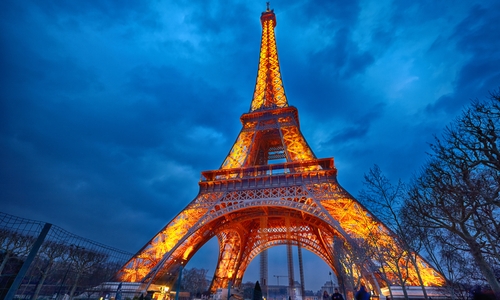By day and by night - two different stories at the Eiffel Tower
Images of the Eiffel Tower lit up at night are protected by copyright laws. If you take a photo and share it online, you may be violating these laws.

Nataliya Hora Nataliya Hora
Many people are familiar with copyright laws being used to protect the creators of paintings, photographs, and musical works. However, buildings, and lightshow displays on buildings, are also considered creative works, protected by copyright law. Taking and exploiting photographs of a copyrighted work for non-personal use, and without permission of the copyright owner, may class as copyright infringement. Copyright tends to last for seventy years from the death of the author, so provided copyright in the work has not expired, the author or copyright owner is entitled to control and exploit their work.When it comes to buildings and architectural works, in most EU countries they may be photographed freely, and resulting images may be published and distributed without restriction, provided the building is located in a public place. Allowing such photographs effectively means that the scope of copyright protection has been restricted, and this is known as “Freedom of Panorama” when the provision is incorporated into national law.
The 2001 Directive
The 2001 “Directive 2001/29/EC of the European Parliament and of the Council of 22 May 2001 on the harmonisation of certain aspects of copyright and related rights in the information society” (“Copyright Directive”) listed certain limitations to the scope of copyright protection that Member States could provide for, one of which related to the use of works such as architecture or sculptures located permanently in public spaces.Belgium, France and Italy have not transposed this particular copyright exception into their national laws, meaning that photographs taken in public spaces may infringe an artist or architect’s copyright in these territories.In contrast, the UK, the Netherlands and Germany allow anyone to take photographs of public buildings without risk of copyright infringement.
The Eiffel Tower
The Eiffel Tower was built in 1889. Copyright in the structure has long-since expired, and so the landmark falls within the public domain. Taking photos during the day, and exploiting these photos, is acceptable. However, the night-time illuminations were added far more recently, in 2003. These are considered an “artistic work”, separate from the structure itself, so reproducing images of the Eiffel Tower illuminated at night requires permission from the Eiffel Tower’s operating company "Société d’Exploitation de la Tour Eiffel" (SETE), who own the copyright.
The Eiffel Tower website makes it clear that use of images of the Eiffel Tower illuminated at night are subject to prior approval from SETE, whilst daytime views are rights-free. Likewise, Belgium’s Atomium building, built in 1958, is also protected by copyright, and Belgium has no scope for Freedom of Panorama. The Atomium website expressly states that the image of the Atomium is protected and cannot be published without permission (and payment). Copyright protection enjoyed in the unique building will expire in 2076.
What is allowed?
This is likely to come as a surprise to many tourists who like to share their holiday snaps online, particularly on social media. Strictly speaking, by sharing photographs of the Eiffel Tower or Atomium, they may have violated French and Belgian Copyright Law as their use of the images is no longer personal once they have been published on a public or commercial website. This applies even if the photograph is their own original shot. People are able to take photos of the Eiffel Tower at night for personal use only and French law does allow for personal tourist photos. However, distributing photos over the internet or posting the photos to social media are arguably non-personal activities that may be prevented by the copyright owner.
Unlike the Eiffel Tower website, the Atomium website expressly states that use of the image of the Atomium is not restricted where photographs are taken by private individuals and shown on websites, social media sites and blogs, for no commercial purpose.
Heavy penalties
Whilst it is hard to imagine SETE sending out a cease-and-desist letter or filing a lawsuit against individuals sharing holiday photos on Instagram, if an image starts to attract economic value or high public exposure, users should be aware that the penalties for copyright infringement can be heavy. The prevalence of infringing images online tends to support the view that individuals are unlikely to be approached, but it is best to err on the side of caution.
SETE would be within their rights to sue, if they felt an image of the Eiffel Tower taken at night had been published or reproduced for commercial gain and without permission.
Sharon Daboul is a registered UK and European trademark attorney at EIP in London. She can be contacted at +44(o)20 7440 9510 or sdaboul@eip.com.
Email your news and story ideas to: news@globallegalpost.com


